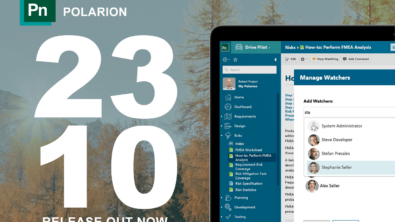Agile Requirements with SCRUM – reality or pipe dream?
 More and more development teams moving to agile methods like SCRUM to manage their software and product development. The key benefits organizations expect to achieve with SCRUM are:
More and more development teams moving to agile methods like SCRUM to manage their software and product development. The key benefits organizations expect to achieve with SCRUM are:
- Transparency, including a clear understanding who is doing what when, plus current project status.
- Better quality, with clear timelines, and all stakeholders committing to them.
- Self-organization, where the development team works responsibly with accountability.
Agile process for development is now widely accepted and nobody really argues the potential to improve efficiency, productivity, and quality. But what about Requirements Management? How can Requirements Engineers be involved? Can Requirements really be agile? At Polarion, we answer that question with a resounding yes! Why such confidence? Because we do it every day in our own development.
Requirements Management should not be a separate “black-box” process/activity separate from the overall development process. Requirements Engineers can (and should!) be an integral part of agile teams just as can the customer/user. The initial “Gathering and Elicitation” of requirements can be managed in an agile way. At Polarion, we have been developing our products using SCRUM methods for years. Based on this experience we have built a collection of best practices around SCRUM and Requirements Management into our products. In his blog series on “Polarion goes SCRUM”, our VP- R&D and SCRUM Master Nick Entin shares the essentials of Polarion’s own SCRUM process and how our teams use Polarion to best advantage. READ THE ARTICLE… Integrating Requirements Management as part of an agile SCRUM-based process is highly beneficial when requirements are subject to change. To successfully achieve this integration, you need a way – preferably automated with some kind of workflow – to carefully manage change to existing requirements, making sure that changes are documented, and also versioned (once again, preferably automatically). Alternatively, you might implement a workflow to ensure a traceable process transfer of modified requirements into a change management process. Either way, you need a tool solution that not only supports agile development, but can also integrate and automate Requirements Management as a “first-class citizen” in the overall process (agile or not). You should be able to automate workflows to ensure no missed steps and timely communication about process flow. The solution should also enable you to easily create traceability across requirements, test cases, and implementation. The ability to analyze the impact of change to implemented requirements across all these areas is a major plus that you should also look for in a solution. Requirements Management solutions from Polarion Software deliver all this capability and more at prices you may be tempted to think are too low to be real. But as over 750,000 users have already discovered, Polarion’s model of building valuable functionality atop cutting-edge open source technologies enables us to provide significant cost-benefit and return on investment. If you would like to know more, there’s still time to sign up for our free Online Requirements and Test Case Management Workshop coming up October 7, 2010. I encourage you to sign up now.


